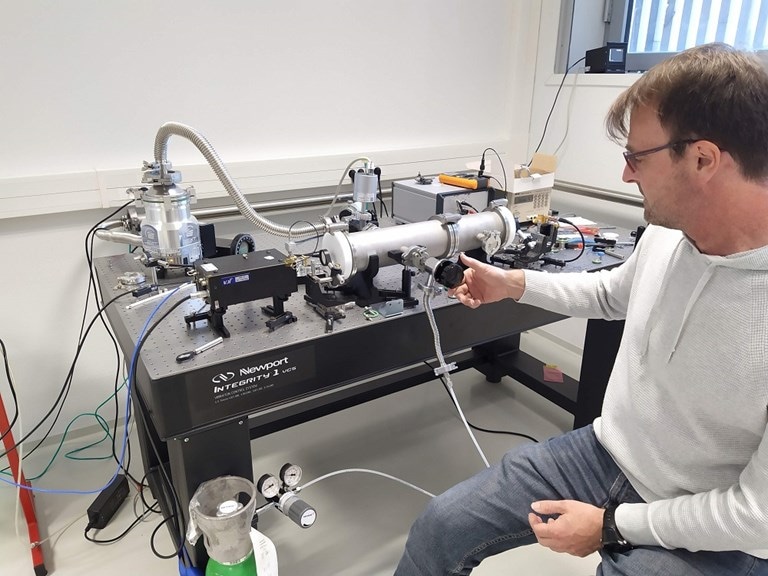Nov 22 2019
A recent development has the potential to boost the sensitivity of high-resolution spectrometers that use terahertz wavelengths to perform chemical analysis.
 Researchers developed a new optical cavity that improves the sensitivity of terahertz spectroscopy. It allows molecules under analysis to interact with the terahertz frequencies over an effective distance of approximately 1 km inside a resonator only 50 cm long. As the waves bounce around, they can be absorbed by molecules many times, allowing a very sensitive measurement. Image Credit: Francis Hindle, Université du Littoral-Côte d’Opale.
Researchers developed a new optical cavity that improves the sensitivity of terahertz spectroscopy. It allows molecules under analysis to interact with the terahertz frequencies over an effective distance of approximately 1 km inside a resonator only 50 cm long. As the waves bounce around, they can be absorbed by molecules many times, allowing a very sensitive measurement. Image Credit: Francis Hindle, Université du Littoral-Côte d’Opale.
Such higher sensitivity may prove beneficial to a variety of applications—for example, the detection of disease biomarkers in patients’ breath and the analysis of the intricate gas mixtures present in industrial emissions. Higher sensitivity can also pave novel ways to identify food spoilage via gas detection.
Now, a research team, headed by Gaël Mouret from the Université du Littoral-Côte d’Opale in France, has reported a novel, high-performance optical cavity for terahertz frequencies. Using this optical cavity, the researchers have demonstrated the world’s first convincing cavity-enhanced spectroscopy carried out with terahertz frequencies. The study has been reported in Optica, The Optical Society’s (OSA) journal meant for high impact research.
On the electromagnetic spectrum, terahertz frequencies fall between infrared light waves and microwaves. With regard to spectroscopic gas analysis, terahertz frequencies enhance the potential to identify an extensive range of molecules and to differentiate between molecules present in a sample. But the technology required to fully leverage the terahertz frequencies is still being developed.
Several studies have used terahertz frequencies to analyze industrial gases emitted into the atmosphere, but they have all been hindered by a lack of sensitivity. Our new optical cavity will expand the types of molecules that can be identified with terahertz gas-phase spectroscopy and improve the feasible detection level.
Francis Hindle, Research Team Member, Université du Littoral-Côte d’Opale
Increasing Sensitivity
Using newly available components, the scientists built a highly advanced terahertz optical cavity—an arrangement of mirrors as well as a waveguide that restricts light so that it reflects numerous times. Since high-finesse optical cavities display very low light loss, they enable the light to bounce between the mirrors several times before allowing it to exit the cavity.
The latest components are a low-loss circular corrugated waveguide as well as a pair of highly reflective photonic mirrors that were specifically developed to function well at terahertz frequencies.
In the case of cavity-enhanced spectroscopy, a gas mixture is positioned in the optical cavity where it communicates with the interior light. The innovative cavity enables terahertz waves to bounce to and fro approximately 3,000 times before exiting the cavity.
This implies that molecules that are being analyzed communicate with the terahertz frequencies over an effective distance of about 1 km within a resonator that measures just 50 cm long. As the terahertz waves bounce back and forth, they can be absorbed several times by any existing molecules, thus enabling a highly sensitive measurement.
A cavity with this finesse has not previously been available at terahertz frequencies. This advance allows terahertz frequencies to be applied to many highly sensitive techniques already used in the infrared.
Francis Hindle, Research Team Member, Université du Littoral-Côte d’Opale
Detecting Rare Molecules
In order to illustrate the cavity-enhanced spectroscopy of a gas with their latest device, the scientists investigated a sample of carbonyl sulfide gas, which exists naturally in the atmosphere. Even though the gas sample contained several isotopes of carbonyl sulfide, the scientists successfully quantified an extremely rare isotope that existed at a concentration of only one molecule per 50,000 molecules.
The ratios of different chemical isotopes present in a sample can be measured to find out the source of a pollutant. The team is planning to increase the range of frequencies for the spectrometer so that the device can be used to inspect much more complex mixtures and molecules.
Our research shows that it is now possible to easily construct high-finesse terahertz cavities and use them for the measurement of gases at high resolution. This could contribute to improved monitoring of a large variety of gases present at very low amounts for applications from environmental and industrial pollution to medicine.
Francis Hindle, Research Team Member, Université du Littoral-Côte d’Opale